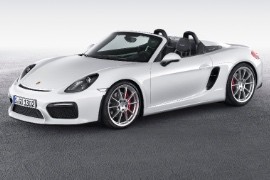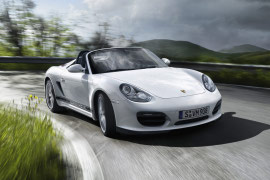PORSCHE Boxster Spyder Models/Series Timeline, Specifications & Photos
First production year: 2009
Engines: Gasoline
Body style: Convertible (spider/spyder, cabrio/cabriolet, drop/open/soft top)
The 2015 Porsche Boxster Spyder is that kind of a roadster that takes something very good and made it better in every way. And add some magic more afterward. It all started with a basic Boxster, which was upgraded with a 911 engine. But this was not enough. Underneath the sleek body reshaped for the Spyder lies a stiffer chassis, bigger brakes and steering carried over the 911 Carrera.
The bodywork was slightly reshaped, with a longer front bumper re-designed in the 1960s Porsche 718 Spyder style. Two humps behind the seats are hiding the manually operated soft-top. Neither radio nor an air conditioner is included as standard equipment to reduce weight. But those were available as an extra option at no extra cost. It was the way that Porsche could differentiate the real car aficionados from those who are just pretending. In the same purist way, the Boxster Spyder was available only with a 6-speed manual transmission.
The total weight of the vehicle was 1315 kg (2899 lbs). The low weight combined with the 375 hp of the natural aspirated 3.8-liter engine flat-six led to serious performances. The 420 Nm (310 lb-ft) torque helped the car achieve a 0 to 100 kph (0-62 mph) sprint time in 4.5 seconds. The top speed was limited to 290 kph (180 mph).
Lose the roof, lose some weight and you'll get a better sports-car than you might think of. It wasn't the quickest or the fastest Porsche in the stable, but it was the lightest and thus, the nimblest.
The Porsche Boxster started slow and shy on the market. It was a cheaper version for a mighty sports-car, but with a mid-engine and less power. But that was in the beginning. By 2009, the Boxster was already a different kind of sports-car than the 911.
A mid-engine car has its appeal and everyone who ever drove one loved it. Except if it was a Pontiac Fiero. But Porsche Boxster was different. It had the power, the quality, and the legacy of an experienced team behind it. Even if it resembled the 911 identity with its round headlights, it had its personality with the mid-mounted cabin, the side-intakes for the engine, and the curved, long, back. The Boxster Spyder featured a twin, round, exhaust in the back, right in the middle of the car, under the apron. The Boxster Spyder was the lightest car in the manufacturer's lineup.
The interior was very similar to the rest of the Boxster range, but with aluminum doors and fixed-back, carbon-fiber, bucket-seats. There was no stereo and no air-conditioning fitted as standard, but those were on the options list.
The engine was a slightly modified 3.2-liter boxer-6 engine. It developed 10 more hp than the regular one fitted on the rest of the range. It was paired as standard with a six-speed manual, but the PDK (automatic, double-clutch) gearbox was available for some extra money. The paddle shifters behind the steering wheel and the launch-control were on the options list as well. With the latter installed, the 0-100 kph (0-62 mph) time was shortened by 0.3 seconds, from 5.1 seconds to 4.8 seconds.

